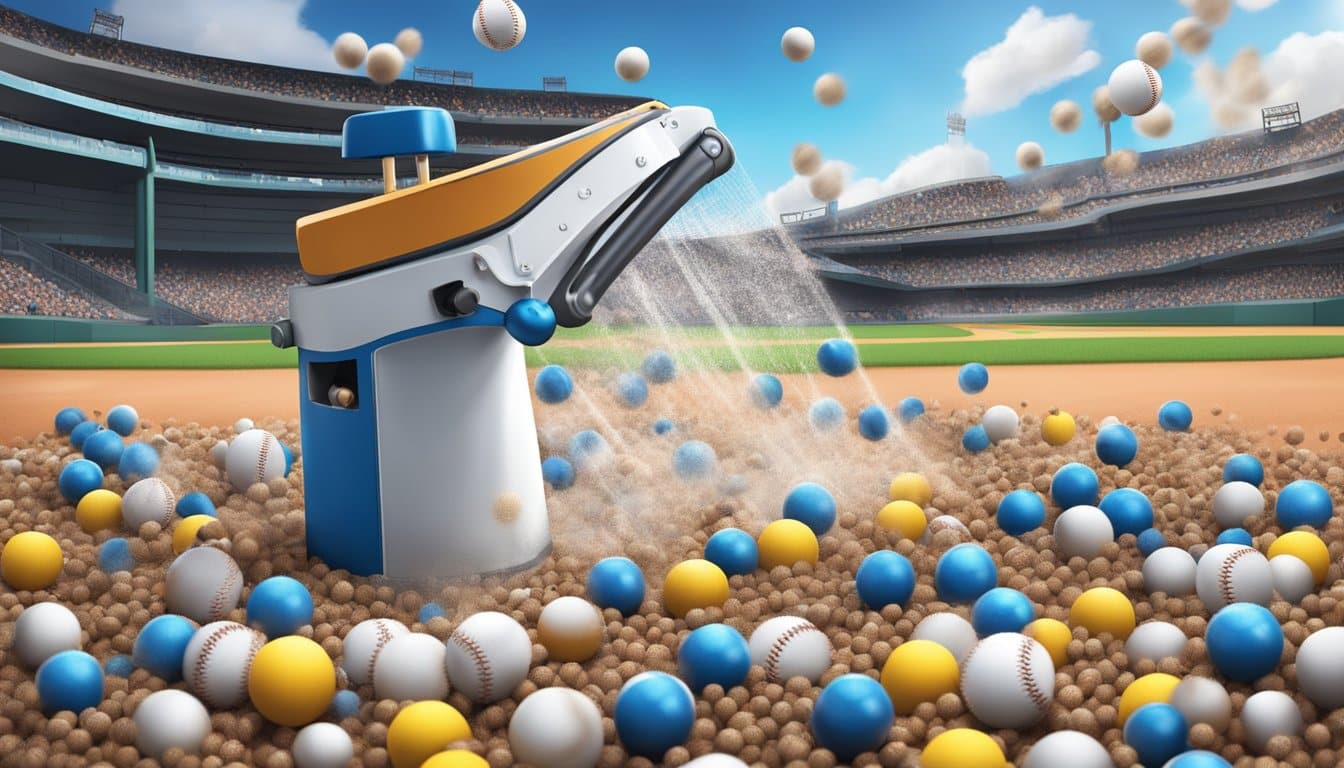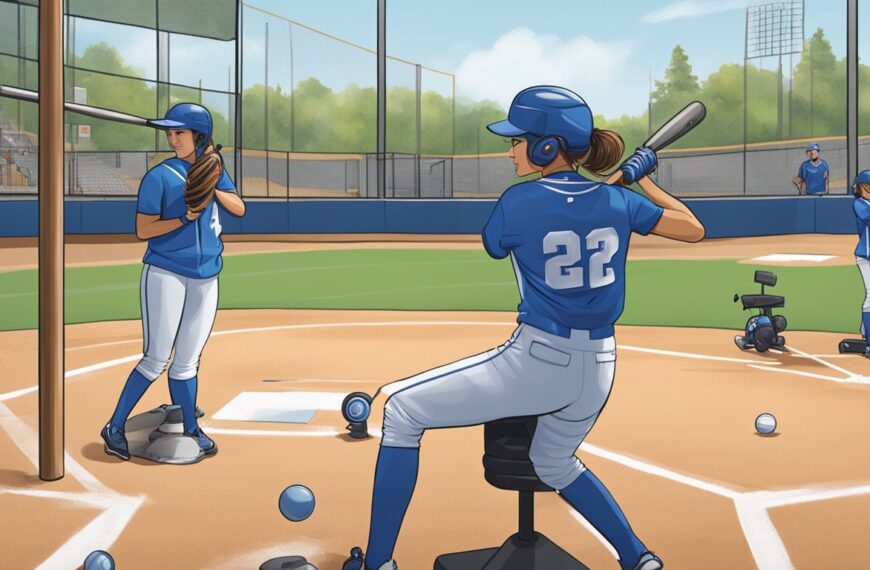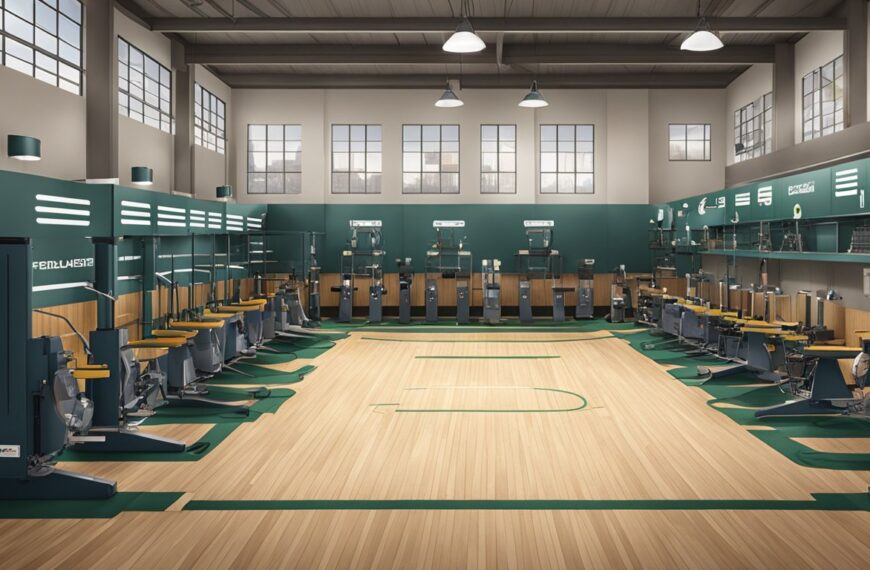Pitching machines have become a staple in baseball and softball training, offering consistent pitches to players without the need for a human pitcher. These machines allow for a high volume of practice swings and help in honing a batter’s skills. However, aside from their contributions to sports, pitching machines have an environmental footprint that is often overlooked. The production, operation, and disposal of these devices carry implications for energy use and waste generation.
The environmental impact of pitching machines stems from their manufacturing process to their energy consumption during operation and eventually, their disposal. Moreover, the materials used in the balls they pitch also contribute to environmental concerns. Strategies for mitigating these impacts can include adopting more energy-efficient designs, using sustainable materials, and ensuring the longevity of the equipment.
Key Takeaways
- Pitching machines benefit sports training but pose environmental challenges.
- Their operation impacts the environment through energy use and material waste.
- Mitigating measures can include efficient designs and sustainable materials.
Overview of Pitching Machines
Pitching machines serve as a crucial training tool in baseball and softball, enabling hitters to practice without a pitcher. These machines are designed to simulate various types of pitches with consistency and precision.
Types of Pitching Machines
- Arm-Style Pitching Machines: They mimic the motion of a human pitcher. An articulated arm accelerates to release the ball, giving a realistic timing element to the batter.
- Wheel-Style Pitching Machines:
- Single Wheel: Utilizes one rotating wheel to propel the ball.
- Two-Wheel: Offers greater control over pitch speed and type, using two rotating wheels.
- Three-Roller Type: Often considered for specialized training, it uses three rollers to pitch the ball with a high degree of accuracy.
Key Components and Technology
- Motor: It’s the heart of the pitching machine, powering the wheels or arm that delivers the ball.
- Control Panel: Enables customization of pitch type, speed, and frequency.
- Ball Feeding System: This system provides a consistent and timely delivery of balls to be pitched.
Technology advancements have greatly improved the efficiency and capabilities of these machines, incorporating electronic components for enhanced performance and user experience.
Environmental Impact Analysis
Pitching machines, used widely for baseball and softball training, have varying environmental impacts stemming primarily from their production processes and energy consumption.
Material Production and Waste
The manufacturing of pitching machines involves the use of plastics, metals, and electronic components. The production of these materials generates waste and can lead to environmental degradation.
- Plastics: Most pitching machines have components made of plastic. The production of this plastic often involves the emission of greenhouse gases. Disposal issues arise once these machines reach the end of their lifecycle, as plastic waste can contribute to landfills and ocean pollution.
- Metals: The use of metals in machines requires mining, which is energy-intensive and often releases harmful emissions into the atmosphere. Metals such as aluminum and steel are commonly used in pitching machines for their durability and strength.
Energy Usage and Emissions
Pitching machines contribute to emissions through energy consumption both during production and operational phases.
- Electricity: They typically run on electricity; therefore, their carbon footprint can be significant, especially if the electricity comes from non-renewable sources. The energy used for manufacturing and usage should be closely monitored for its environmental impact.
Energy Source Emission Intensity Coal High Natural Gas Medium Renewables Low - Battery Operation: Some models are battery-operated, raising concerns about battery production and disposal. Rechargeable batteries, while reducing the need for constant replacement, still hold environmental impacts due to the materials used and energy required for charging.
The environmental footprint of pitching machines is complex and dependent on a multitude of factors from production to disposal. The use of sustainable materials and energy-efficient designs can help mitigate these effects.
Benefits of Pitching Machines in Sports
Pitching machines have revolutionized the way athletes train for ball games, offering precise and consistent practice sessions across various sports.
Advancements in Baseball Training
Pitching machines provide baseball players with consistent pitches at various speeds and styles. A player can refine their batting technique against a myriad of pitch types without the variability that a human pitcher might introduce. This consistency allows hitters to practice specific scenarios repeatedly, leading to improved skill and muscle memory. They can adjust the machine to simulate left or right-handed pitchers, as well as the curveballs and sliders they might face in actual games.
Cross-Sport Utilization
The utility of pitching machines extends beyond baseball into sports such as football and rugby, where they can be adapted to throw not just baseballs but also footballs and rugby balls. This multi-sport adaptability enhances training versatility. In football, for instance, pitching machines are used to simulate passes for receivers, improving their catch consistency and reaction time. For rugby, these machines can be tuned to replicate various types of kicks, helping players master their receiving and ball handling under different conditions.
Technical Aspects of Pitching Performance
In analyzing the technical aspects of pitching performance, specific parameters such as ball speed, spin rate, and pitch trajectory play a critical role. These factors directly impact the outcome and quality of pitches delivered by mechanical devices.
Ball Speed and Exit Velocity
The ball speed refers to the velocity with which a ball is thrown by a pitcher or projected by a pitching machine. Exit velocity is the speed of the baseball after it is hit by a batter. Notably, faster pitch speeds typically result in higher exit velocities. For instance:
- Fastballs often yield higher exit velocities due to their higher pitch speeds compared to other pitch types.
- Dynamic stiffness affects the energy transfer from the pitching machine to the ball, influencing the resultant ball speed and exit velocity.
A table exemplifying standard speeds for MLB pitches:
| Pitch Type | Average Ball Speed (mph) |
|---|---|
| Fastball | 90-95 |
| Curveball | 75-80 |
Spin Rate and Pitch Types
The spin rate is the number of rotations a baseball makes per minute (rpm) around its axis when thrown. Different pitch types, such as the curveball and fastball, rely heavily on spin rate:
- A curveball achieves its movement from the high spin rate and the resulting aerodynamic forces.
- The fastball usually has a considerable amount of backspin, which contributes to its stability and perceived rise as it approaches the plate.
Employing a high-speed video camera in coordination with a sophisticated coordinate system allows for accurate measurement of ball rotation and spin rate.
Machine Calibration and Pitch Trajectories
Calibrating a pitching machine requires precise adjustment of machine parameters to replicate various pitch types. Ball rotation and wheel speed are critical aspects for emulating pitches like MLB players:
- Wheel speed affects the initial velocity and the type of pitch, such as a fastball’s speed or a curveball’s arc.
- Pitch trajectories depend on the machine’s settings, ensuring that the simulated pitches have realistic flight paths.
The use of a coordinate system assists in defining the three-dimensional path of the pitch, allowing coaches and players to analyze and adjust technique accordingly.
Impact on Training and Practice
Pitching machines provide significant benefits for batting practice, specifically in enhancing batting technique and ensuring consistency and safety during practice sessions.
Enhancing Batting Technique
Pitching machines offer a reliable way for players to improve their batting technique without the variability that comes from human pitchers. They allow batters to focus on specific types of pitches and batting stances, leading to better muscle memory and skill refinement.
- Repetition: Players can receive a high volume of pitches at desired speeds and styles, aiding in the reinforcement of batting skills.
- Adjustments: Batters can work on their swing mechanics against consistent pitching, allowing them to adjust and perfect their batting techniques.
Consistency and Safety in Practice
The use of pitching machines in batting cages can provide a safe and controlled environment for players to practice, minimizing the risk of injury from inconsistent pitches.
- Pitching Consistency: Machines offer repeatable pitches, which helps batters anticipate and react, ultimately building confidence and competence.
- Controlled Environment: By using machines, practice settings become safer as the risk of wild pitches or accidental hits by a pitcher is greatly reduced.
Wear and Durability of Sporting Goods
Sporting goods, like baseballs and pitching machines, face significant wear over time, influencing their performance and cost-effectiveness. Understanding these impacts helps in making informed decisions about sporting equipment usage and maintenance.
Impact on Balls and Equipment
Balls: Over time, baseballs undergo wear due to repeated impact with bats and pitching machines. The physical properties such as hardness and coefficient of restitution change, which can affect the ball’s performance. Balls may lose their compression, leading to decreased effectiveness, especially for breaking balls and sliders.
Equipment: Pitching machines themselves experience wear, particularly in the mechanisms that propel the ball. Parts can degrade, requiring maintenance or replacement. Wear can be analyzed using finite element analysis to predict equipment lifespan and maintenance schedules.
Longevity and Cost Considerations
Cost: The cost of frequently replacing balls and repairing pitching machines can be significant. Investing in durable, high-quality equipment may have higher initial costs but prove more cost-effective over time.
Longevity: Proper maintenance of both balls and pitching machines can extend their lifespan. For instance, storing balls in a controlled environment helps maintain their physical properties, and regular servicing of machines can prevent excessive wear.
Wear and Durability Table:
| Factor | Impact on Balls | Impact on Equipment |
|---|---|---|
| Physical Properties | Compression loss; reduced hardness | Mechanism degradation |
| Cost | Frequent replacement | Initial investment vs. maintenance |
| Maintenance Required | Regular inspection | Scheduled servicing |
Environmental-Friendly Alternatives
This section examines materials and practices in pitching machines that are more environmentally sustainable. It presents critical advancements in materials and carbon footprint reduction strategies.
Innovations in Eco-Friendly Materials
Manufacturers are now using polymeric foam balls and elastomeric foam to minimize environmental impact. These materials are notable for their low density, which translates to less material used per ball and a lighter product that requires less energy for transport. The use of these foams makes balls:
- Durable: Withstanding repeated use without significant degradation.
- Recyclable: Allowing the material to be reused and keeping it out of landfills.
By utilizing eco-friendly materials, companies contribute to a healthier climate by reducing waste and decreasing the demand for raw materials.
Reducing the Carbon Footprint
Focusing on the carbon footprint, there are several strategies manufacturers and facilities can employ:
- Renewable Energy Sources:
- Utilizing solar panels or wind turbines to power pitching machines.
- Investing in renewable energy credits or carbon offset programs.
- Energy-Efficient Design:
- Engineering machines with lower energy consumption.
- Incorporating automatic shutdown features to conserve power when not in use.
These initiatives help in reducing greenhouse gas emissions, contributing to climate stabilization by aligning with global sustainability goals.
Seasonal and Climate Considerations
Pitching machines’ operations can substantially vary with changes in weather patterns and seasonal shifts. These fluctuations impact both the frequency of use and the maintenance requirements of the machines.
Effect of Rain and Weather on Usage
Rain significantly affects the use of pitching machines. Wet conditions can lead to:
- Reduced Usage: Rain can make baseball fields unplayable, decreasing the opportunity to use pitching machines.
- Maintenance Challenges: Increased moisture can cause corrosion and electrical issues.
Outdoor pitching machines require waterproof covers and must be stored properly to avoid weather-related damage.
Adapting to Different Seasons
Pitching machines need adaptations for seasonal changes to ensure longevity and performance:
- Summer: Machines should have protection from overheating and direct sunlight to prevent wear on materials.
- Winter: Cold conditions may necessitate winterization of machines to prevent damage to mechanical components.
Clearly, strategic care and adjustments are crucial for the year-round use and sustainability of pitching machines.
Conclusion
Pitching machines represent a small, yet relevant piece of the broader environmental puzzle. They consume electricity, with the higher-end models often being more energy-intensive. Their usage, predominantly in baseball and softball training, leads to increased energy demand.
Material Use and Waste: The production of pitching machines involves metals, plastics, and electronic components. At end-of-life, improper disposal can lead to environmental harm.
Energy Consumption: The electricity used by these machines contributes to their carbon footprint, especially if sourced from non-renewable power plants.
Renewable Energy Solutions: Operators are encouraged to connect these machines to renewable energy sources to reduce impact.
Maintenance and Lifespan: Regular maintenance can prolong the life of pitching machines, while responsible recycling at their end-of-life can minimize waste.
In summary, the environmental impacts are multifaceted, involving material use, energy consumption, and waste generation. Adopting renewable energy and promoting long-term usage through proper maintenance are practical measures that can mitigate these effects. Responsible disposal methods at the end of a machine’s life are crucial for minimizing harm to the planet.
Frequently Asked Questions
The impact of pitching machines on the environment is a multifaceted issue, involving their energy consumption, manufacturing materials, maintenance, and disposal. This FAQ section addresses these concerns with concise answers.
What are the ecological consequences of using electric pitching machines?
Electric pitching machines require electricity, which, depending on the energy source, can lead to greenhouse gas emissions. These emissions contribute to climate change and can harm ecosystems if the energy is produced by fossil fuels.
How does the energy consumption of pitching machines contribute to their environmental footprint?
The environmental footprint of pitching machines is partly determined by how much energy they consume. Machines that are inefficient or used extensively increase demand for electricity and, consequently, the potential for higher emissions.
Are there eco-friendly alternatives to traditional pitching machines?
Yes, there are eco-friendly alternatives. Some models use solar power or manual operation to reduce reliance on electricity generated from non-renewable resources.
What materials are used in manufacturing pitching machines and how do they affect the environment?
Pitching machines are typically made from plastics, metals, and electronic components. The extraction, processing, and transportation of these materials can lead to resource depletion and pollution.
How can the maintenance and disposal of pitching machines impact ecological sustainability?
Improper maintenance can lead to shorter machine lifespans, prompting more frequent replacements and waste. Responsible disposal means recycling parts when possible and following environmental regulations to prevent pollution.
In what ways can using pitching machines in sports training be made more environmentally friendly?
Sports training with pitching machines can be more environmentally friendly by using energy-efficient models, powering machines with renewable energy, ensuring proper maintenance, and choosing models made with sustainable materials.















